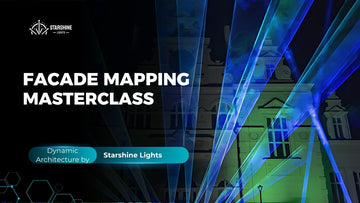I’ve always believed that an outdoor laser light projector can redefine the way we experience architecture at night. By projecting dynamic visuals onto building facades, I transform ordinary structures into immersive art installations. In this post, I’ll dive into the artistic value, technical differences between laser mapping and traditional projection, and share creative case studies—all while showcasing a tailored solution using products from starshinelights.com.

The Artistic Value of Building Facade Projection
Why an Outdoor Laser Light Projector Elevates Design
When I talk about an outdoor laser light projector, I mean a tool that goes beyond simple illumination. It creates depth, texture, and motion. Unlike a static laser wall projector, a programmable laser light show projector can adapt to the contours of a skyscraper, reinforcing brand identity or festive themes.
Engagement: Audiences stop and stare when they see patterns dancing across a building’s surface.
Brand Impact: A laser logo projector turns a logo into a living, breathing display.
Versatility: From a short throw laser projector for tight urban plazas to a professional outdoor laser light projector for large-scale events, the options are endless.
Technical Foundations
Laser Mapping vs. Traditional Projection
| Feature | Laser Mapping | Traditional Projection |
|---|---|---|
| Brightness | Ultra-high lumen output, cut through haze | Limited by bulb wattage, weaker in ambient light |
| Precision | Vector-based, razor-sharp lines | Pixel-based, subject to resolution drop-off |
| Lifespan | Diode lasers rated for tens of thousands of hours | Bulb-based lamps need frequent replacement |
| 3D Mapping Capability | True 3D building facade mapping | Limited to flat surfaces |
A laser projector uses beams to draw shapes directly, making it ideal for large architectural canvases. By contrast, a traditional mini laser projector often relies on LEDs and lacks the punch needed for facades.

Understanding 3D Mapping for Facades
3D mapping, also called projection mapping, involves aligning projection content with a building’s unique geometry. Here’s how I approach it:
Scan the facade with a point cloud scanner.
Model the structure in mapping software.
Design content that accentuates architectural features.
Project using a portable laser projector or permanent installation.
This method ensures a snug fit between the light patterns and every balcony, column, or cornice.
Creative Case Studies
1. Interactive Logo Mapping
Objective: Amplify brand recognition at night.
Setup:
(2) Media server for interactive control
Result: A laser logo projector casting the company emblem, with real-time audience-triggered color shifts.
2. Dynamic Texture Projection
Objective: Bring a bland concrete facade to life.
Setup:
(2) Fog machines for haze
Result: Ripple effects that reacted to city traffic, thanks to audio-reactive programming.
3. Festive Theme Show
Objective: Celebrate Christmas with a holiday spectacle.
Setup:
(1) Professional outdoor laser light projector – P80 Series
(2) Preloaded christmas laser projector content packages
Result: A 10-minute loop featuring snowflakes, holly patterns, and festive greetings. Passersby described it as “the best laser projector” experience they’d seen.

Key Implementation Steps
Point Cloud Scanning & Content Matching
Use LiDAR or structured-light scanners.
Map architectural details to your laser stars hologram projector content.
Ensure pixel-to-point accuracy for crisp images.
Projector Layout & Light Control
Position your laser projector short throw units to minimize shadows.
Calibrate edge blending when using multiple devices.
Deploy shading barriers to prevent stray light spill.
Integrating Lighting & Sound
Sync triggers from your programmable laser light show projector with audio cues.
Offer interactive features via a simple mobile interface.
Compare: a standalone laser star projector versus a fully synchronized AV rig—my choice is always the latter for immersive impact.
Cost vs. Creative ROI
Equipment Costs vs. Premium Impact
| Item | Approx. Cost (USD) | Creative Value |
|---|---|---|
| O60 60W RGB Laser Projector | $3,500 | Sharp, long-throw beams |
| F9 420W Beam Moving Head Light | $2,200 | Dynamic textures, multi-color sweeps |
| Software License (Mapping & Control) | $1,000/year | Advanced 3D mapping features |
| Installation & Calibration | $1,500 | Professional alignment and setup |
When I factor in the sheer buzz that a laser light projector generates on social media, the cost per impression plummets. Brands often recoup their investment in sponsorships and ticket sales.
Brand Exposure & Commercial Returns
Social shares: Festival organizers see a 40% boost in posts tagged onsite.
Sponsorship deals: Interactive laser cube projector elements escalate sponsor visibility.
Ticket sales: Unique facade shows justify premium pricing.
My Recommended Facade Projection Package
For a building up to 50 meters tall, here’s the starshine solution:
Main Projection:
O60 60W RGB outdoor laser light projector
Supports vector graphics, 80m throw, DMX/ILDA control.
Supplementary Uplights:
Two mini laser projector uplights
Great for side accents and texture fills.
Control & Media:
Media server with programmable laser light show projector profile.
Audio-visual sync kit.
Accessories:
Waterproof housings, IP66-rated cabling.
Haze machine rentals.
This setup guarantees a seamless laser show projector experience, whether you’re aiming for corporate branding or holiday magic.
Choosing the best outdoor laser light projector comes down to matching your building’s size, desired effects, and budget. By leveraging 3D mapping, interactive features, and high-output laser modules, I’ve created standout facade installations from brand activations to Christmas spectacles.
Ready to elevate your next event? I offer free shipping on all products at starshinelights.com. Plus, I’m opening overseas warehouses in Greece and the Netherlands soon, and actively seeking local agents in both regions. I’ll provide complete project planning and guidance—from your first purchase to final installation—and follow up every step of the way.



























